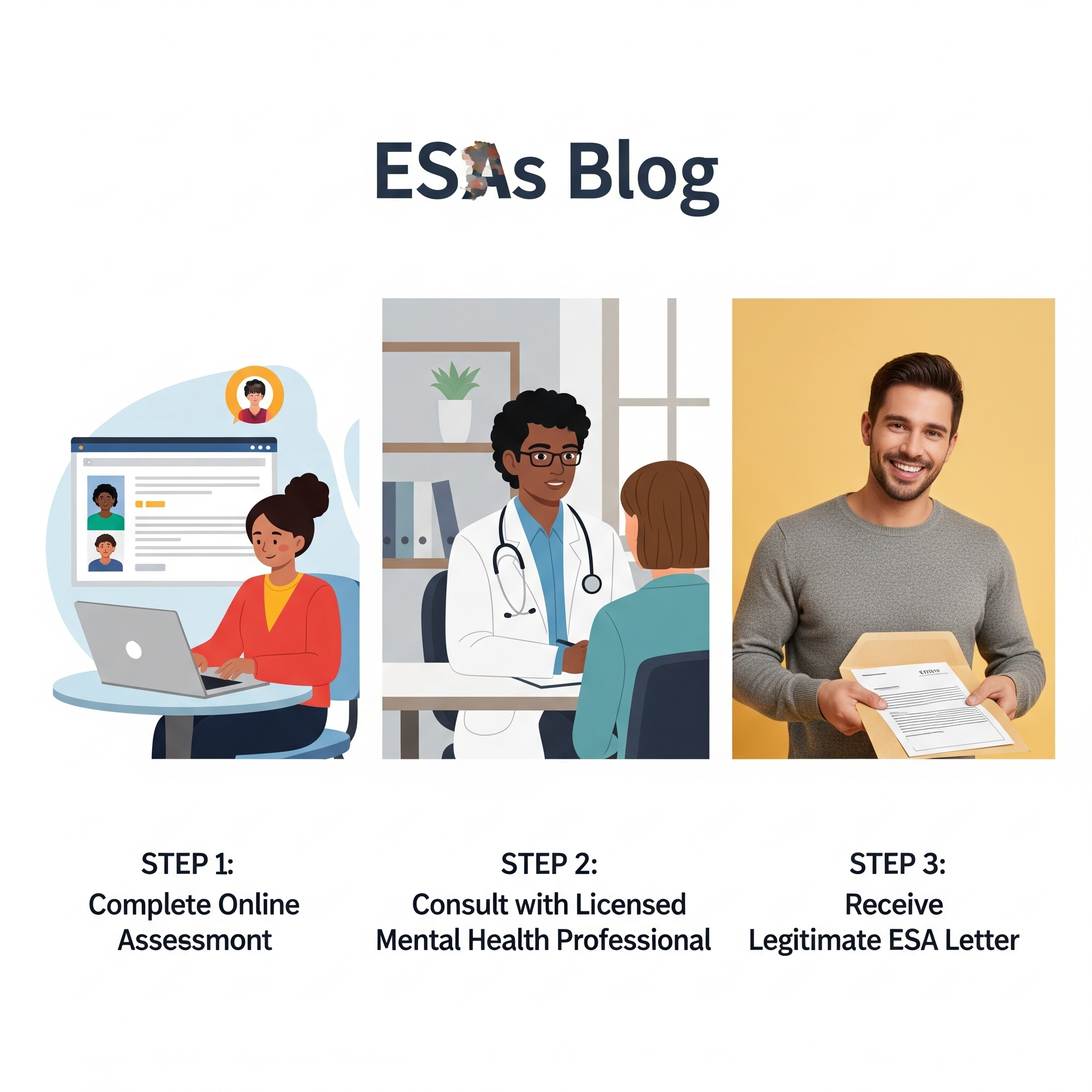Unveiling the Profound Impact of ESAs on Well-being
In an increasingly complex world, the search for effective mental health interventions is more critical than ever. While traditional therapies and medications play a vital role, a growing body of scientific evidence highlights the profound impact that Emotional Support Animals (ESAs) can have on alleviating symptoms of various mental health conditions. Far from being merely pets, ESAs provide a unique form of companionship and therapeutic presence, acting as a crucial component in many individuals’ wellness journeys.
At CertifyESA, we understand the significant difference an ESA can make. Our mission is to connect individuals with licensed mental health professionals who can assess their needs and provide legitimate ESA and PSD letters, ensuring they receive the accommodations necessary to thrive with their supportive companions. But what exactly is the science behind this powerful human-animal bond? Let’s delve into the fascinating neurological, physiological, and psychological mechanisms that underpin the therapeutic benefits of Emotional Support Animals.
The Human-Animal Bond: A Foundation for Healing
The concept of the human-animal bond isn’t new. For centuries, animals have been companions, protectors, and sources of comfort. However, modern scientific inquiry has begun to unravel the intricate ways in which this bond translates into tangible mental health benefits. This isn’t just about “feeling good” – it’s about measurable physiological and psychological changes.
Neurochemical Responses: The Brain’s Feel-Good Chemistry
One of the most compelling areas of research focuses on the neurochemical changes that occur during human-animal interaction. Studies have shown that interacting with animals, particularly through petting or close contact, can trigger the release of several key neurotransmitters and hormones associated with well-being and stress reduction.
-
Oxytocin: Often referred to as the “love hormone,” oxytocin plays a crucial role in social bonding, trust, and attachment. Research indicates that petting an animal can lead to a significant increase in oxytocin levels in both humans and animals (Beetz et al., 2012; Handlin et al., 2012). This surge in oxytocin promotes feelings of calm, comfort, and a sense of security, directly combating feelings of anxiety and loneliness.
-
Dopamine: This neurotransmitter is central to the brain’s reward system, influencing pleasure, motivation, and mood. Positive interactions with an ESA can stimulate dopamine release, leading to improved mood and a sense of happiness (Odendaal & Meintjes, 2003).
-
Serotonin: Known for its role in regulating mood, sleep, appetite, and social behavior, serotonin levels can also be positively influenced by human-animal interaction. Increased serotonin contributes to feelings of well-being and can help mitigate symptoms of depression.
-
Cortisol Reduction: Conversely, studies have consistently demonstrated that interacting with animals can lead to a decrease in cortisol, the primary stress hormone (Barker et al., 2005; Beetz et al., 2012). Lower cortisol levels are associated with reduced stress, anxiety, and improved overall physiological calm.
These neurochemical shifts illustrate a direct biological pathway through which ESAs exert their therapeutic effects, creating a physiological state conducive to improved mental health.
Physiological Benefits: Beyond the Brain
The impact of ESAs extends beyond neurochemistry to direct physiological responses that contribute to mental well-being.
-
Lowered Blood Pressure and Heart Rate: The calming effect of interacting with an ESA can manifest in measurable reductions in blood pressure and heart rate (Allen et al., 2001). This physiological relaxation is particularly beneficial for individuals experiencing chronic stress, anxiety, or panic attacks.
-
Improved Cardiovascular Health: Long-term interaction with companion animals has been linked to better cardiovascular health, potentially due to reduced stress and increased physical activity (Levine et al., 2013). While ESAs are not primarily for physical health, the interconnectedness of mind and body means these benefits can indirectly support mental resilience.
-
Pain Reduction: Some studies suggest that the presence of an animal can even help reduce perceived pain (Chur-Hansen et al., 2012). This may be due to the distraction and comfort provided, which can shift focus away from discomfort and activate the body’s natural pain-relief mechanisms.
These physiological changes are not merely anecdotal; they are documented responses that underscore the tangible, measurable benefits of the human-animal bond.
Psychological Mechanisms: How ESAs Alleviate Mental Health Symptoms
Beyond the biological, ESAs employ several psychological mechanisms that directly address common symptoms of mental health conditions.
Reducing Loneliness and Isolation
One of the most pervasive challenges in mental health is loneliness, which often exacerbates conditions like depression and anxiety. ESAs provide unwavering companionship and unconditional love, significantly reducing feelings of isolation. Their constant presence offers a sense of connection and belonging that can be profoundly comforting.
Promoting Routine and Responsibility
Caring for an ESA introduces a sense of routine and responsibility into an individual’s life. This can be particularly beneficial for those struggling with depression or other conditions that disrupt daily structure. The need to feed, walk, and care for an animal provides a sense of purpose and motivation, encouraging engagement with the world outside of one’s internal struggles.
Increasing Physical Activity and Outdoor Engagement
For many individuals with ESAs, especially dogs, there’s an inherent need for regular walks and outdoor activity. This consistent physical movement is a known mood booster, reducing symptoms of depression and anxiety, and improving overall physical health. Being outdoors also exposes individuals to nature, which has its own proven benefits for mental well-being.
Enhancing Social Interaction
Animals, particularly dogs, can act as social catalysts. Walking an ESA often leads to incidental social interactions with other pet owners or passersby. This can reduce social anxiety and provide opportunities for positive human connection, which is vital for mental health.
Providing a Sense of Security and Safety
For individuals with anxiety or PTSD, the presence of an ESA can offer a profound sense of security and safety. Their intuitive nature allows them to often sense distress in their human companions, responding with comforting physical contact or presence. This can create a feeling of being protected and understood, reducing hypervigilance and fear.
Distraction and Mindfulness
Interacting with an ESA can provide a healthy distraction from distressing thoughts or emotional spirals. Focusing on an animal’s needs, playing with them, or simply observing their behavior can pull an individual into the present moment, fostering mindfulness and reducing rumination.
The Distinction: ESA vs. PSD
While both Emotional Support Animals and Psychiatric Service Dogs provide invaluable support, it’s important to understand the key distinctions, especially regarding legal protections and functional roles.
-
Emotional Support Animals (ESAs): ESAs provide comfort and emotional support through their presence. They do not require specialized training to perform specific tasks related to a person’s disability. Their primary role is to alleviate symptoms of a mental health condition through companionship. Under the Fair Housing Act (FHA), individuals with a legitimate ESA letter are granted reasonable accommodations to live with their ESA, even in “no-pet” housing.
-
Psychiatric Service Dogs (PSDs): PSDs are specially trained to perform tasks directly related to an individual’s psychiatric disability. These tasks can include, but are not limited to, reminding an owner to take medication, interrupting self-harming behaviors, providing deep pressure therapy during anxiety attacks, or guiding individuals experiencing disorientation. PSDs are considered service animals under the Americans with Disabilities Act (ADA) and have broader public access rights compared to ESAs.
CertifyESA connects individuals with licensed mental health professionals who can assess whether an ESA or PSD is appropriate for their specific needs and provide the necessary documentation.
The CertifyESA Advantage: Ensuring Legitimate Support
Obtaining a legitimate ESA or PSD letter is crucial for ensuring legal protections and avoiding scams. At CertifyESA, we prioritize ethical practices and compliance with federal guidelines.
-
Licensed Professionals: We connect clients with licensed mental health professionals (LMHPs) who are qualified to conduct thorough evaluations. This ensures that your letter is issued by a credible source with verifiable credentials.
-
Comprehensive Assessment: Our process involves a comprehensive mental health assessment to determine if an ESA or PSD provides a therapeutic benefit for your qualifying mental health condition. This isn’t an “instant approval” service; it’s a legitimate clinical evaluation.
-
Adherence to Federal Laws: Our letters are designed to comply with the Fair Housing Act (FHA) and, for PSDs, the Americans with Disabilities Act (ADA). This ensures that you have the proper documentation to secure housing accommodations.
-
Privacy and Security: We uphold strict privacy and security standards for all client information, ensuring a confidential and trustworthy process.
Real-Life Impact: Testimonials of Transformation
The scientific data is compelling, but the true power of ESAs is often best illustrated through the personal stories of those whose lives have been transformed. While specific testimonials from CertifyESA customers are proprietary, the broader community of ESA owners frequently shares similar experiences:
-
“My anxiety used to be debilitating, making it hard to even leave the house. Since I got my ESA, just knowing she’s there, her calming presence, has made a world of difference. I can breathe easier, and I’m starting to reclaim my life.”
-
“Battling depression felt like a constant uphill climb. My ESA gives me a reason to get out of bed every day. The routine of caring for him, and his unwavering affection, has been a lifeline.”
-
“For years, I struggled with panic attacks. My psychiatric service dog is trained to alert me before one starts and then uses deep pressure therapy to help me calm down. It’s truly life-changing to have that level of support.”
These narratives, echoed by countless individuals, underscore the profound and often life-saving role that Emotional Support Animals play in mental health management.
Conclusion: A Scientific Basis for Compassion
The science behind Emotional Support Animals and their impact on mental health is robust and growing. From the intricate dance of neurochemicals to the profound psychological benefits of companionship, routine, and social facilitation, ESAs offer a unique and effective therapeutic modality. They are not a “cure-all,” but for many, they are an essential component of a holistic mental health treatment plan, providing comfort, stability, and a pathway to improved well-being.
At CertifyESA, we are proud to facilitate access to this vital form of support. By connecting individuals with licensed mental health professionals for legitimate ESA and PSD letters, we empower them to harness the scientific benefits of the human-animal bond and live fuller, healthier lives with their cherished companions.
APA Formatted Citations:
Allen, K. M., Blascovich, J., & Mendes, W. B. (2001). Cardiovascular reactivity and the presence of pets, friends, and spouses: The truth about cats and dogs. Psychosomatic Medicine, 63(5), 721-729.
Barker, S. B., Pandurangi, B. K., & Best, A. M. (2005). Effects of animal-assisted therapy on patients’ anxiety, fear, and depression. Psychiatric Services, 56(10), 1324.
Beetz, A., Uvnäs-Moberg, K., Julius, H., & Kotrschal, K. (2012). Psychosocial and psychophysiological effects of human-animal interactions: The possible role of oxytocin. Frontiers in Psychology, 3, Article 234.
Chur-Hansen, A., Winefield, H., & Beck, T. (2012). The effect of companion animals on subjective feelings of pain. Anthrozoös, 25(2), 209-216.
Handlin, L., Hydbring-Sandberg, E., Nilsson, A., Ejdebäck, M., Jansson, A., & Uvnäs-Moberg, K. (2012). Effects of dog ownership on the oxytocin system and well-being. Anthrozoös, 25(2), 217-227.
Levine, G. N., Allen, K., Braun, L. T., Christian, K., Friedmann, E., Taubert, K. A., … & Lange, R. A. (2013). Pet ownership and cardiovascular risk: A scientific statement from the American Heart Association. Circulation, 127(23), 2353-2365.
Odendaal, J. S. J., & Meintjes, R. A. (2003). Neurophysiological correlates of affiliative behaviour between humans and dogs. The Veterinary Journal, 165(3), 323-331.





